#pakistani protagonist
Text
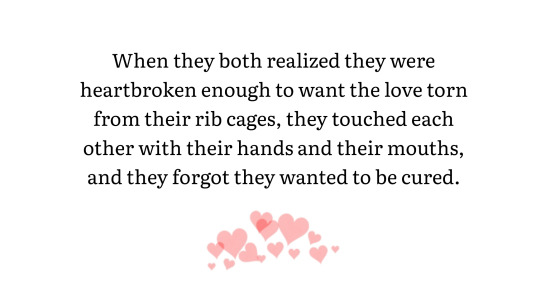
–Anna-Marie McLemore, When the Moon Was Ours
#book quote of the day#anna marie mclemore#when the moon was ours#Valentine's day reading recs#magical realism#ya books#bipoc representation#lgbtqia+ literature#transgender protagonist#pakistani protagonist#latinx protagonist#mexican-american author#James Tiptree Jr Award winner#Stonewall Honor Award winner#young adult fantasy#romance books#own voices#gorgeously written#book recommendations
24 notes
·
View notes
Text

making them the sappiest most romantic little horror podcast protagonists you know how it is
[image description: a pink-tinted digital illustration of martin blackwood chasing jonathan sims amidst falling papers and a manila folder over a blue glowy background with hearts. in the top left and bottom right corners are papers with closeups of martin and jon's faces in them - martin is blushing sheepishly and smiling while looking off to the side, holding a pen to his chin, and jon is blushing and looking angrily flustered at the viewer while gripping his tie. he has heart pupils. martin is a fat, tan-skinned, mixed white and filipino man, wearing a white collared shirt and a red tie. jon is a thin, brown-skinned pakistani person, wearing a pink jacket and a blue tie. surrounded by them are various objects - several pens, an overturned blue mug of green tea, and a lighter with a web design on it. end id]
#AAAUGH#the magnus archives#tma#the magnus archives fanart#jonmartin#jonathan sims#martin blackwood#ali draws
554 notes
·
View notes
Text
also for newer followers who might not know

i'm writing a book! and it's getting published!
if you just want the immediate details you can click the read and read a short FAQ! if you need more to get sold on it, stick around and check it out!
My YA SFF fantasy debut, ALVOSKIA: Call of the Infrans, follows an Unchosen one named Ally who is struggling to find where she belongs amidst her chosen one found family family when violence arrives at their doorstep, and they're forced to fulfil their duties earlier than expected. There's dragons and child soldiers and subverted fantasy tropes, some tone consistent werewolves, an almost entirely queer main cast with the majority also being characters of colour, and if you've been following my blog for any amount of time, it probably has something for you.
If you like ATLA: "what if there were multiple Avatars running around, and what if they weren't all automatically good people?" + past lives and reincarnation cycles
If you like Derry Girls: hot mess of teenagers getting in and out of trouble together while being ridiculous (and sometimes very sad)
If you like PJO: young teenagers with cool powers going on quests together and coming-of-age. And snark. Lots of snark
If you like Six of Crows: morally dubious collection of protagonists, some heisting may or may not happen, outsiders working together
If you like TDP: elves and dragons and long standing grudges and politics
If you like Star Wars: y'know how the Force like consumes you the farther you wander in? yeah that's the magic system here. + some shadow, death, and shapeshifter stuff
If you like HTTYD: you're here for the found family and fun fantasy aesthetic aren't you
Rep: queer (aro, ace, bi, pan, trans, lesbian, nonbinary, genderfluid, gay main characters, often times overlapping); Asian (Indonesian), Black, Sri Lankan and Pakistani (coded) rep; hijabi rep; one character is an amputee and one main character is Autistic.
The debut month is March 2026! Sometimes there is even very pretty (commissioned or friends) art for it:

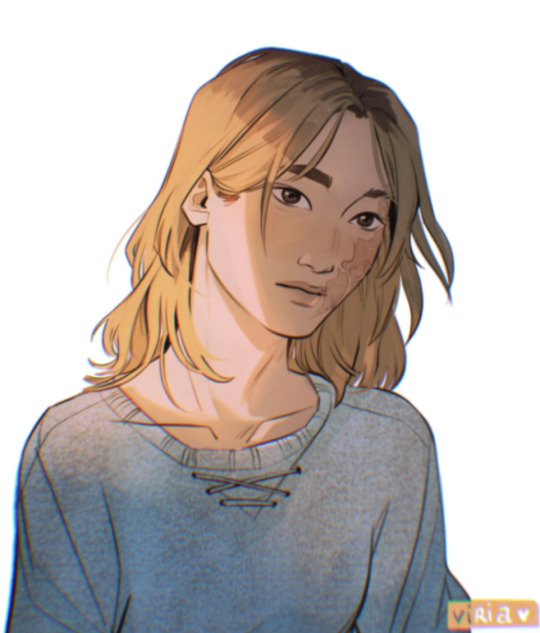
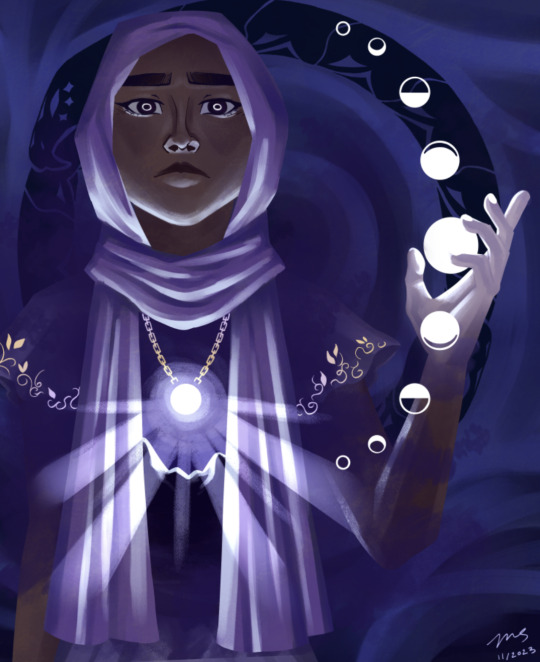
If you want more info in the meantime you can shoot me an ask or you can follow this sideblog for it. If you want a taste of my fandom writing first you can check out my AO3 or writing snippets on said side blog, like this one:
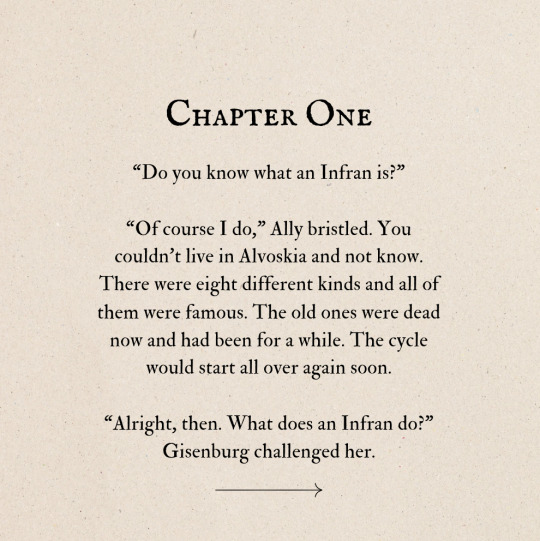
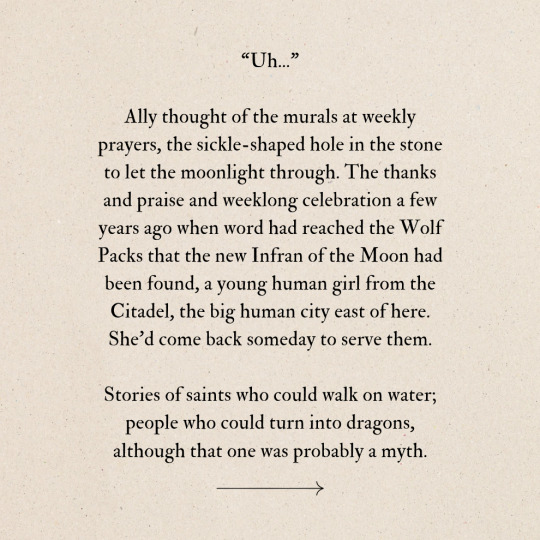
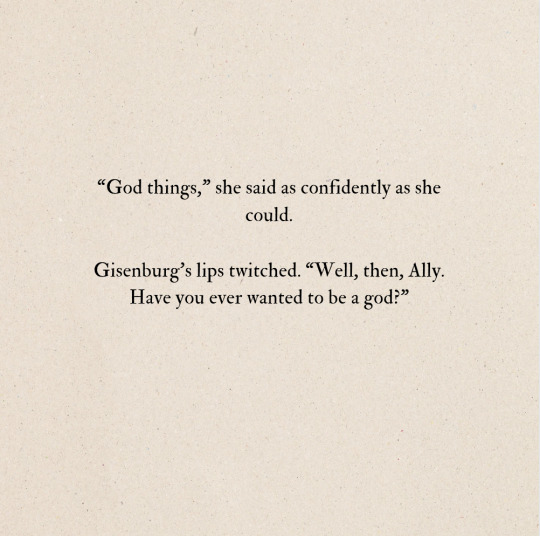
Likes and reblogs mean a lot and I hope you enjoy!
#indie author#sff ya#sff#young adult#writeblr#fantasy#original character#infrans#alvoskia#atla#pjo#derry girls#httyd#sw#six of crows
35 notes
·
View notes
Text


PROPAGANDA
KAEDE AKAMATSU (DANGANRONPA V3)
1.) (Spoilers for the game but)
First female protagonist in the three main games of the series. Advertised as the protagonist in all of the game’s trailers and was hyped up, only to get brutally killed off at the end of the first chapter for shock value and to be replaced with a male protagonist. It’s revealed in the end that the reason she died was completely made up and she was killed for convenience.
In the one chapter she’s in there’s a scene of her taking her shirt off, as well as a joke about the male protagonist accidentally looking up her skirt while she’s climbing a ladder. Her legacy for the rest of the game is basically to act as the male protagonist’s reason for character development as he tries to become stronger.
2.) So disclaimer first that I think Kaede is actually really well-written as a character. She’s interesting and feels fleshed out and despite dying early on, she haunts the narrative so strongly that she was one of my favorite characters for the whole game AND she’s vital to the climax of the story. All that said…
Kaede was marketed as the protagonist of the game, making her the first female protagonist in the main DR series (there’s a female protag in a spin-off but the two other games in the main series both had male protags). You start the game and you immediately notice she has a stronger personality than either of the male protags from the previous games, who, while I like them, tend to be the normal ones in an otherwise colorful cast. She felt like a break from the usual protag mold and we even got to have a male secondary character this time who relied on her for support. But. She isn’t the protag. The guy I just mentioned is. You find out mid-trial 1 that Kaede is (sorta unintentionally) the killer and you switch control to the guy character and Kaede then dies at the end of the trial. As far as a plot goes, this was really really cool and well-executed, but it also means the game intentionally decided to pull a bait-and-switch where they advertised the “first female protag of the series!” only to kill her off early on and reveal the true protag was actually a guy who, once again is a character I like, but is much more similar to the previous two protags than Kaede was. There was literally no reason they had to put a female character as the false protag here, as the twist would’ve worked equally well or maybe even more if they revealed a typical male protag character was the killer and instead switched to a female protag for the rest of the game. Advertising Kaede as the first female main series protag while knowing she would be dead for the majority of the game and the actual protag would be a guy feels cheap and insulting, especially as a female player who was really excited to play as Kaede.
3.) She was the protagonist! But god forbid danganronpa has a female protagonist so (spoilers) she actually has to die sorry :( and then only exist in flashbacks the new male protagonist has where hes like damn wish we couldve dated
KAMALA KHAN (MARVEL COMICS) (CW: Racism)
1.) One of the most prominent brown women in all of comics, beloved by the fan base. Recently killed in a PETER PARKER SPIDERMAN COMIC (despite being much closer with Miles Morales and having basically no relationship with Peter) in what’s probably the name of MCU synergy, which nobody wanted (she’ll probably be resurrected as a mutant, erasing her unique and interesting history as an Inhuman). She was using her shapeshifting powers again despite having stopped in her solo as she got more confident in her own skin and identity as a Pakistani American girl, died disguised as the very white Mary Jane as a fake out/last minute replacement for killing off MJ. I fucking hate it here. A cheap trick to drive sales. L + Misogyny + racism + are you fucking kidding me
45 notes
·
View notes
Note
hey! everyone's been really talkative about this IF so I wanted to jump on the train :) do you think you could tell me about the RO routes and like, the vibe of them? i want to start planning out my characters now becuz the release date is next month! (congratulations btw)
also, ik this is a romance book, so I wanted to ask if there's a bunch of romance scenes/small romance stuff included? (ie; them holding hands, sneaky looks, etc) cuz some books advertise as a romance but like only include like 5 scenes, you feel me? the plot seems super cool and im intrigued! but romance also plays a huge part in my satisfaction so just, wanna know!
sorry if this comes off as rude 😭😭
Not rude at all! Though, honestly, I'm not 100% sure how to answer this.
Blood Moon is defiantly more romantic than a lot of games, but it's not as romantic as others. There are romantic scenes and moments, dates, and explicit content, but a large chunk of the game is also... not that.
Like the tagline says: date werewolves, fight vampires.
So, for every werewolf kiss, expect to have to punch a vampire or two.
If anyone who has played Blood Moon would like to comment on the romantic aspect of the game please do. As the author, I feel like I'm not the best person to describe it, because when I write the game I see every possible outcome, so it might seem different for me than someone playing it through.
As for vibes... There are eight romanceable characters and the feel of each romance is different.
CliffsNotes version:
Marco is a lanky blond guy who likes to joke around. He's got some insecurities, because he had a shitty upbringing, but he's also fiercely loving and loyal. He tends to 'match' with the player's character a lot, eg, when running side by side, they always run in lockstep. His romantic route has a lot of BFF to lovers vibes.
Vicky is a tall, muscular woman with a dark past. She's terrifying on the battlefield, but very soft and gentle with those she loves. Her romantic route is about finding peace and softness in a world at war. Great if you want to play a more world wary protagonist, through she can mesh with other sorts of characters too.
Ed is young, ambitious, cheeky, and idealistic. He's probably the most 'human' of the werewolves and strongly believes the world can and should be a better place, though he sometimes uses underhanded methods to make that happen. His route is pitched a little younger, and can include some 'first love' vibes.
Shawnie is a curvy red head with a sassy personality. She's very sexual but actually probably one of the hardest to win the heart of. You have to really get to know her, and prove that you're interested in her for her, before she really shows you her heart.
Roe is a non binary person, very beautiful, with long hair and a lean build. They can come across as aloof or cold, until you get to know them, then they'll show a fierce and passionate side. Romance route is VERY star-crossed lovers. They're torn between desire and duty.
Farro is the resident DILF. He's VERY tall and muscular. Think Pakistani lumberjack. He's also, in contrast to appearances, quite shy and reclusive. He has an eight year old daughter that is the opposite to him in almost every way. Be nice to the kid to win his heart.
Sergi is a stocky man, dark hair, dark eyes, and is older than the player's character by a decade or two (he will call you 'pup'). He has a playful personality, but undergoes some serious trauma throughout the story, so loses that for a large chunk of the game's runtime. The romance is a little forbidden love, but leans more toward shared trauma bringing people together.
Carrie is small, skinny, and covered in sharp edges. She can be rude and abrasive, especially before she gets to know the player's character, but beneath that has a heart of gold, for those willing to take their time to get to know her. Enemies to lovers, but perhaps not in the traditional sense.
I hope that helped.
82 notes
·
View notes
Text
The last three Love Like Salt tales in Cinderella Tales from Around the World consist of one from Pakistan and two from India.
*These tales stand out in two chief ways from their European counterparts. First, by not following the standard Cinderella or Donkeyskin storyline after the princess is banished, but going in completely different directions until the standard father/daughter reunion ending. Secondly, by handling the meaning of "love like salt" in a different way. Where the European versions emphasize that food without salt is tasteless, these South Asian versions instead skewer the poetic cliché of equating love with sweetness and point out that savory food is just as necessary as sweet food, if not more so.
**The king asks his many children (more than just three, and in one case including sons as well as daughters), how much they love him, and all but the youngest daughter reply "Like sugar," "Like honey," "Like sweetmeats," etc. But the youngest daughter says "Like salt," so her father has her abandoned in the jungle.
**In the end, she invites her father (or her entire family) either to her wedding feast or just to visit her home. She serves no food but sweets, which her father soon tires of, and when she finally serves him salted food instead, he realizes the value of salt.
*As for what happens in the middle of the story...
**The Pakistani tale of The King and His Daughters is the simplest: a prince just finds the princess hiding in a hollow tree, falls in love with her, and marries her.
**In one of the two Indian tales, both titled The Princess Who Loved Her Father Like Salt, the princess comes to a palace where a prince lies dead, with many needles sticking out of his body. One by one she pulls out all the needles, somehow knowing that this will bring him back to life, but one day she pauses to take a bath, and her slave girl pulls out the last two needles instead, reviving the prince. She tells him that she's the princess and marries him, reducing the real princess to a slave. But eventually he learns the truth and replaces the false bride with the true one. And refreshingly for this type of story, the slave girl isn't killed or severely punished, but forgiven by the princess, though she is forced to serve her again.
**In the other Princess Who Loved Her Father Like Salt, the princess is newly wed and pregnant when her father banishes her, and she ends up giving birth and raising her son in a golden palace in the jungle. The boy becomes the protagonist, who goes on a journey that involves rescuing three fairies from a Deo (giant) and winning half the kingdom by granting a wish of the king's. He then takes the king (his grandfather) to see his mother, reuniting the family.
Now for some footnotes from me:
*I'm surprised that this book doesn't include any Love Like Salt variants from the Americas, because I know they exist. There's a picture book from the '80s called Moss Gown, which I remember reading in elementary school, which is based on an oral version from North Carolina. That version is problematic, because it takes place in the South before the Civil War, on plantations full of slaves, and because the white heroine's helper is a a black "witch woman," a literal case of a "magical Negro." But I do like what she gives to the heroine: a dress that by day is a raggedy thing made of moss, but which turns into a beautiful ballgown at night. I wish a European variant or two had shared that detail.
*I'm also surprised and disappointed that this book doesn't include the Ashkenazi Jewish variant How Much Do You Love Me? (a.k.a. The Way Meat Loves Salt), where the father is a rabbi, the heroine's love interest is a rabbi's son, and her magical helper is the prophet Elijah in disguise, who gives her a magic stick that grants her wishes. That version has also been adapted into a picture book, which I've sometimes seen in the gift shop at my local synagogue's annual Jewish Food Festival. @ariel-seagull-wings has also shared it here.
The next set of Cinderella tales in this book are the subtype of One-Eye, Two-Eyes, Three-Eyes.
@ariel-seagull-wings, @adarkrainbow, @themousefromfantasyland
#cinderella#love like salt#fairy tale#variations#cinderella tales from around the world#heidi ann heiner#pakistan#india#tw: needles
10 notes
·
View notes
Text
There are Pakistani dramas like Kuch Unkahi and Yunhi, which have soft, humanly, positive male protagonists played by Bilal Abbas and Bilal Ashraf, Even the character of Wahaj Ali in Mujhe Pyar Hua Tha. Yet we have the audience of two nations going bonkers over a character that is romanticising marital rape.
It is so problematic that,
People are not even considering it Marital Rape because they are married so something as much as "Rape" cannot exist as consent goes down the shit hole if you're married.
The whole idea that we live in such a mind numbingly ignorant society that the director, producer, storywriter and even all the actors involved couldn't care less about the fact that something as problematic and severe as this should not be shown in a prime time drama serial.
THERE SEEMS TO BE NO SIGN OF A TRIGGER WARNING?????
or any message saying that they don't fucking support or condemn something as disgusting as marital rape
Shame on literally everyone involved and everyone justifying it.
If it was to be a serious story which would have a social message or it was supposed to send out a message that dont fucking rape your wives, it would have been acceptable. they are legit ROMANTICISING it in literally such a weird manner.
so many people, women, children suffer from domestic violence. and for these people, violence is only a mere act of gaining views, trp and having a climax in the show.
41 notes
·
View notes
Text
Intro to RAPTURE ACADEMY
(so remember a few months ago I said I wanted to make a list of characters for a fighting game? It has a name now lol)
RAPTURE ACADEMY is a superhero/alternate history project centrally focused around the Rapture Academy and Institute for Superpowered Opportunists, a school thinly designed to raise supervillains. Primarily focusing on the stories and systems around a bunch of kids with intensely dangerous powers enrolled in a private academy headed by imprisoned supervillain No. 1 Angel as part of an internationally-backed plea deal. The kids are alright.
STUDENTS:
Anti (Canadian) - Analog horror-themed hoodie kid with dark powers (makes everything they hit distort like a broken VHS tape), surprisingly nice and wholesome and probably the least likely to actually become a career villain.
Hellbound ("Eastern European") - Princess sacrificed to a draconic ritual, became a half-dragon berserker who spends her time bound in magic chains. A demure sweetheart when lucid, murderous beast otherwise.
The Vigilante Smog Monster/"Smoggy" (Australian) - A swamp monster summoned by an indigenous tribe searching for a protector, can turn into sludge and murder smoke, wears enchanted wooden masks.
Twintails (Japanese) - two students in one! A male wizard apprentice and a female ninja apprentice from rivalling clans that were fused together by a trickster yokai; one person is in control at a time, they swap from sneezing.
IDKYS/I Don't Know You, Sorry (Filipino) - Aspiring idol/daughter to high-ranking entertainment execs with a literally hypnotic voice. Placed in school with a voice-to-computer TTS mask in order to be taught a lesson in humility, is the class queen anyway.
Magnus VI (American) - Indestructible cyborg cowboy built by a mad science firm who can explosively self-destruct any joint in his body before reassembling. Extremely arrogant. No one touches his hat.
Metal Alice (French) - Daughter of a supervillain who died and was brought back as a haunted animatronic unknowing that she died. Is a walking portal to the ghost dimension who can pull out all sorts of phantasmic metal weapons, from scissors to chainsaws.
Hot★Shot (Chinese) - Cocky martial arts prodigy, has fire abilities, up-and-coming superstar. Basically thinks he's the protagonist of a shounen fighting game, is a colossal asshole from it, yet is the popular jock regardless.
Vioelectrolysis (Motswana) - Upbeat mad scientist-in-training who fights using a giant modified fire-extinguisher that mixes chemicals for deadly use, as well as a bigass flail for deadly use. She may or may not be a mutant.
White Slate (Greek) - A living statue accidentally created by a mad artist, has the ability to turn people into stone with his touch. Is missing a face, sometimes paints one on for intimidation points. Mostly an emo boi who paints a lot.
zZomnia (Pakistani) - Phoneaholic teen haunted by nightmares that double as guardian spirits with insanely powerful weapons whenever she's asleep or is on the verge of it. Is constantly sleepy. Leave her alone.
Bitter Batter (N/A) - Just an ordinary girl with no superpowers, but a baseball bat, a silent death glare, and murderous intent. Originally a teen vagrant before being enlisted in the school. The most "normal" student and also the most fn terrifying
Moonlight Rosebloom Powderpuff of the Unside Neverlandian Court (Scottish?) - A bubbly (alleged) fairy noble from a (disputed) faraway realm hidden in a (presumably) magical garden. Wields (conversely very real) magic. It's very pink.
Ryvr Sticks (Ukrainian) - A scarecrow infected with a paranatural fungi giving him sapience, regeneration abilities, and hallucinogenic powers. Indisputably the class clown and source of gossip. Is a wicked breakdancer.
FACULTY:
No.1 Angel (███) - Headmaster, part-time supervillain, full-time asshole. thinks he's a superhero who deserves to protect humanity but then gave another superhero cancer using his light manipulation powers for trying to stop him.
Panopticon (███) - head of security, a silent dude in black armor and an old-timey diving helmet who sometimes appears unacknowledged to stare at everyone in class, in hallways, or off campus. Powers unknown.
Señor Heartpuncher (Mexican) - Teacher of self-defense. Retired lucha-themed super with a long history of being a hero, but once had a heel-turn and became teacher because he owed a favor to No.1 Angel. has the ability to absorb and reflect kinetic force, perfect for teaching kids how to hit punches then tank them
Drill Instructor Friday (Brazilian) - Teacher of phys ed. Acts like the scariest and most intense drill instructor you can think of. She's also a genuine werewolf. Comes up with some of the funniest PG-13-level insults imaginable and then punishes you for laughing at them.
OfOz (Haitian) - Teacher of paranatural arts (magic, anomalies, anything "supernatural"). Pretty chill and charismatic expert in the field, is able to split his soul/body separately. Only one half of him is teaching classes, other half is doing supervillainy elsewhere in the world.
DDDD (South Korean) - Teacher of technology arts. Is the head of a megacorp developing devices for supers, mostly villains. Teaches remotely from the other side of the world using a mini-mech suit that she pilots from her office. It has weapons. She forgets this. Frequently rants about her competitors and has to be reminded by her secretary to stay on topic.
Sir SPECTACULAR!!! (Swiss) and The Virtuoso (German) - Teacher and assistant teachers of theatrics (getting students to figure out their gimmicks/brand/performances as supers). They used to commit "theatre crimes" together with SPECTACULAR!!!'s super-conductor powers and Virtuoso's super-VR tech, turning cities into musicals. After turning the state of Oklahoma into a musical, they've settled down teaching kids and enjoy it.
Mr. Professor Von Ruin (Austrian) - "Teacher" of ethics (the legalities and philosophies of being a super). he is actually a cat. a super-intelligent, talking cat, pet of a supervillain, but a cat. he doesn't really teach, so his period's just a free block.
Miss Brutalist (Swedish) - Teacher of logistics (resourcing and management of being a super). No powers, actually runs a business designing HQs and lairs for various supers. Most of her assignments involve getting students to do paperwork for her projects.
Dr. Infinity-Plus (Hungarian) - Teacher of general sciences and maths. Has incredible foresight/caculation abilities, which drove him... not quite "insane" but very jaded, paranoid, and antsy. Will often derail classes to vent about existentially terrifying concepts. wears a Rubik's cube-like helmet to dampen his mind.
Sewn Chaos (Azerbaijani) - Teacher of home economics. Former career super before using her textile-manipulation powers to design costumes for others, helps the kids figure out their costumes. genuinely like everyone's favorite grandma up until she shares stories of all the f'd up villains she worked with. Good times!
DREADNAUT (Russian) - Head librarian. Ghostly cosmonaut afflicted by paranatural forces while on the moon, now has gravity powers but is stuck in a fugue state. manages the school's library containing vast resources... which is constructed upside-down in order to make it harder for kids to access.
Gutwrencher (Czech) - Head nurse. A zombie in all but name, has a flesh-mending/regeneration factor she can use to heal herself and others. Is constructed out of various necrotic body parts and stitching that often come apart at inconvenient times. Some students are attracted to her and don't know why.
Mr. BRB (Italian) - Head janitor (and also the only one). He's a necromancer who summons ghouls to help do the cleaning for him but often still leaves things dirty. Mostly chills out in his office to record his personal podcasts and offer advice to kids who ask nicely.
7 notes
·
View notes
Text
Between Ms Marvel and Polite Society, Nimra Bucha is really cornering the market on evil Pakistani moms that menace the teenage female protagonist
#good for her good for her let her keep doing it#the opposite thing is going on with Shobu Kapoor#where i am so used to seeing her as Amina's mom that whenever she did anything mean in Bridgerton S2 or in Polite Society I went D: D: D:#polite society
40 notes
·
View notes
Text
It's a 'reboot' AU. And naturally, nothing is the same.
He's Afro-Pakistani. He has central brown-green heterochromia in both eyes. He's bisexual. He has ADHD. Moles and freckles are everywhere on his skin. He's gender-nonconforming. He's a HUGE nerd when it comes to the space opera genre and comic books. He cosplays. He writes fanfiction. He paints his nails. He's the literal opposite of 'straight white male teen protagonist' that we usually receive in Transformers media and it's glorious.
And honestly? There's nothing more incredible, more powerful, than creating a character or a version of an already pre-existing character and saying "death to cringe culture" because it's not forced diversity- people just exist.
7 notes
·
View notes
Text
Those supposed "fans" of Marvel that say Ms Marvel is awful and boring because it's exploring Kamala's background as an American Pakistani and just wanted to see her in action with her glowing powers teaming up with a well-known superhero are really annoying. You just wanted her to appear, kick butts and maybe say one word or two in urdu?
Are you really saying that all her history and how she was born in America is irrelevant because she isn't kicking people in the first episodes like Marc Spector?
Why are you trashing the series for that fact? The first Captain America movie was about Steve's begginings as a World War soldier against the Nazis and you cheered and enjoyed it.
But when it's about the history of India against the British and how much these people have suffered and the generational long-time consequences of it, you make jokes about "Yeah, I'm the girl who is supposed to kick butts but instead I'm giving you Pakistani history classes: The series" or "I fell asleep at the story of the protagonist's great grandfathers. How boring"
And that is only the Hispanoamerican's side of the Marvel Fandom I'm talking about. I can't image how the gringo fandom is "dealing with" this right now.
Unbelievable... but very believable at the same time. I guess the majority of my community prefers Americans fighting Nazis and the history of their own countries over learning about Asia's long battle with the British.
125 notes
·
View notes
Text
It’s been so long since I had an actual reason to post, but here we go!
I want to talk about Dead End Paranormal Park.
And no, contrary to what my previous posts may suggest, I’m actually not going to be focusing on the-frankly awesome-rep of all kinds. Still, it’s worth a mention! I mean, come on! Our main characters are a trans gay jew and an autistic bi pakistani girl!!


But that’s not what I’m going to focus on here. Instead, I want to take the chance to focus on how well Hamish Steele uses highly underutilized tropes in an absolutely brilliant manner.
Spoilers ahead! Be warned, if you see anything you regret, just keep it to yourself darling!
Now for the big stuff: The usage of a Lawful Good antagonist and the morality shift of a protagonist whose ideals have been so challenged and so hurt by those they thought they could trust, that they instead turn on the so-called ‘good’ to fight with ‘evil’.
Now, before I get into details on that last one, let’s start strong with the Lawful Good Antagonist! Like I said, very underutilized, and very hard to do well. The problem with the concept of a ‘lawful good’ antagonist is that they genuinely have to have no ulterior motives to their good; their only goal is to achieve a ‘good’ thing, at any cost. In this case, that’s eradicating the Demons, even at the cost of Humanity, whom they have sworn to protect—after all, what cost is the Neutral Plane if it means the threat of Demons is eliminated? Absolute order must be maintained, and the demons’ very existence threatens to break that order with their Chaos and Evil.
We have seen, too, that it’s not so simple, hence why Hamish Steele does such a good job with this concept. After all, Fingers has selfish motivation, doesn’t he? He’s not Lawful Good. But he is a servant of it, which ultimately means that his actions are meant not to show that the Angels aren’t as good as they seem, but instead to show the lengths they will go to in a character who isn’t as pure as the rest. He, like the Watcher, serves as a foil to the Angels as a whole, showing their sinister side—whereas the Watcher shows their absolute devotion to their cause, and the lengths they will go to to achieve it.
Seeing how well it was done inspires me, because it shows that it can be done, and it can be great. I mean, Angels?? As the villains?? Let’s face it, we can all probably count on one hand how frequently that works out.
And now, for the second trope done well. Or, rather, possibly done well. We haven’t seen it play out yet! But I will say, this is not only a new trope, I don’t think I’ve ever actually seen it executed before: A protagonist on the side of good turning to ‘evil’ in order to get justice. And I’m not taking Red Hood style evil, or justice. Norma turning to the Demonic Royal Family is a smart move, and totally in character for her. More than that, it makes sense. While it’s true that it could be viewed as her becoming evil, that’s not actually the case. She’s become an anti-hero by siding with dark forces with potentially terrible goals, because she knows that the Angels need to be stopped. And more than that, she wants to hurt them like they hurt her. So, a little Red Hood I guess! But still, if we do get season 3-and I’m really hoping we do-we have a chance to see a massive reversal in a manner I can genuinely say that, in all my years as a film and tv studies major, I have never seen executed well.
If done right, Hamish Steele could create an entirely new genre of storytelling, and I for one truly hope that we can see it in all its glory.
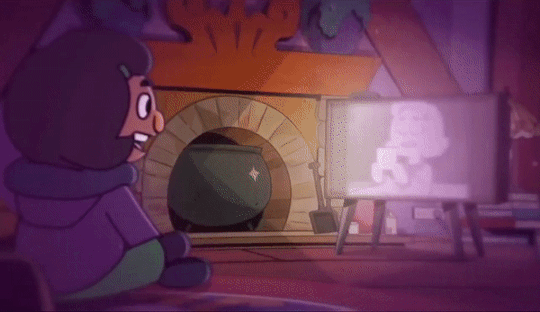
#dead end#dead end paranormal park#dead end netflix#hamish steele#norma khan#barney guttman#animation#cartoon
95 notes
·
View notes
Text
The love story between Hasan and Aisha is beautiful. I've seen so many different versions of this story, but seeing it from a new cultural context is like re-experiencing it again for the first time.
This is the part of the story that a lot of people have problems with. And I can understand why. Our lead protagonist Kamala is out of the picture for half of the episode, for the sake of showing us in great detail a family story that's been brought up a couple times already.
But to a critic, this is good stuff. It's meaningful and substantive. We're seeing the Indian Partition with our own eyes and hearing the story of people whose lives were affected by it, as told through the lens of actual Pakistani filmmakers. This is real history interwoven into the fantasy; A fantasy which connects directly to the history being examined.
Aisha, as she encourages Hasan to run, says this: "We can take our memories with us. So long as we're together, we can build a home anywhere." And that's it. Right there. That's the thing. That's what Najma cannot accept. What drives a homicidal wedge between Aisha and Najma.
Aisha carries in her heart the philosophy of the refugee. She seeks to live and to live well, regardless of where she must do it.
Much like Moon Knight, the fifth episode of Ms. Marvel drops the pretense and says, "This. Just, this. This is what we're talking about, okay? This is what the metaphor is covering. We're talking about this. The Noor, the Clandestines, Najma and Aisha, it's all a metaphor for the effects of Partition on the people who suffered through it."
And. Then. Kamala. Through the kinda-wonky time travel effect, Kamala becomes roped into these events and in a literal sense becomes a critical piece of her family's founding mythos. It's an elaborate way of inserting Kamala into her heritage and Kamala's heritage into her.
That's the statement being made here: Kamala was always a part of this history, just as this history will always be a part of her. The Bangle was always here and she was always connected to it. Her family, history, and culture have always been interwoven with Kamala's power and identity, even before she truly understood what any of it meant. She stands on the shoulders of everyone who loved her even before she existed, and the events both good and bad that brought her lineage to this point.
This moment, when Kamala connects with her heritage in the most intimate way possible, is her catalyzing moment. This is where she finds her strength to self-actualize and become the hero.
9 notes
·
View notes
Text
“Amphibia” Emphasizes Chosen Families and Self-Acceptance
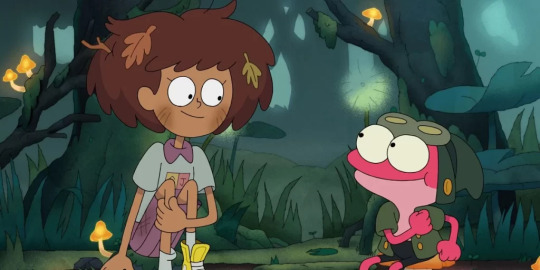
What if a Thai-American girl wakes up and finds herself in a world filled with talking frogs? Amphibia answers that question. Anne meets new friends, enemies, and tries to figure out her purpose in this strange world.
Reprinted from The Geekiary, my History Hermann WordPress blog (it will be published on there on Dec. 26), and Wayback Machine. This was the forty-second article I wrote for The Geekiary. This post was originally published on June 25, 2022.
Amphibia is an animated adventure-fantasy-comedy series by Matt Braly, an animator of Thai descent. He is also known for directing episodes of Gravity Falls and Big City Greens.
As a warning, this recommendation discusses spoilers for all three seasons of Amphibia.

Amphibia centers around a 13-year-old Thai-American girl, Anne Boonchuy (Brenda Song), who is transported by a music box to another world with her two best friends, Sasha Waybright (Anna Akana) and Marcy Wu (Haley Tju). In this wild land, filled with marshes and tropical environments, she meets talking frogs and other creatures, including a family of frogs named the Plantars.
This family is headed by the overbearing and traditional grandfather, Hop Pop (Bill Farmer). He has two kids-of-sorts: an excitable frog named Sprig (Justin Felbinger) and a spunky pollywog named Polly (Amanda Leighton). All of them live on a farm of their own in the close-knit town of Wartwood. As Anne bonds with the Plantars, she learns what friendship and being heroic means.
This all-ages animated series is filled with diversity, especially from its characters and voice actors. The latter are of Chinese, Indonesian, Pakistani, Japanese, and Thai descent. The show compliments this with wonderful animation, music, and background art.
Unsurprisingly, the series has been been nominated for four Annie Awards, one Daytime Emmy, and a GLAAD Media Award since it began airing in 2019. It includes some voice actors I'm familiar with, like Tress MacNeille and John DiMaggio, who voice characters in Disenchantment, as well as well-known gay actor George Takei.

From left to right: Sasha, Marcy, and Anne with "cool anime" powers in the final episode of Amphibia, floating the air like anime heroes or Kid Cosmic protagonists
Amphibia is more than a series centered on a girl who is adopted by a family of talking frogs. While there is the classic conflict of good vs. evil, there is also a focus on family separation, self-acceptance, and trauma. As I wrote previously, all of the main protagonists have trauma on same level or another, as the friendship between all three of them faces hardships and strains.
This is all mixed together with fantasy and sci-fi elements, and even occasionally situational comedy acts. These complex characters are written in such a way that you become invested and concerned about them, even after ending the series. The series also has plotlines focused on human and animal experimentation, and robots.
This series is part of a recent set of diverse Disney animated series. Others include The Ghost and Molly McGee, a supernatural fantasy, and will-be-ending horror comedy and fantasy The Owl House. Upcoming series such as Iwaju, Moana: The Series, Tiana, Cookies & Milk, Hailey's On It!, and Marvel's Moon Girl and Devil Dinosaur portend a continuation of this focus.
In the case of Amphibia, Braly based the series on his trips to Bangkok, Thailand where he thought he was an outsider. He also was inspired by video games like The Legend of Zelda and Chrono Trigger. In previous interviews he said he wanted to make the main character a Thai-American because there were few Thai protagonists in TV series or films that he watched as a kid. As a result, he has said he become influenced by the Mortal Kombat and Sonic the Hedgehog franchises.
In a December 2021 interview, Braly noted the themes of immigration, alienation, and xenophobia drawn from his own experiences. All of these themes are deeply integrated into the series. Some of this is heavily informed, according to Braly, by the 1990s series, Pepper Ann. Braly also noted that frogs were chosen for the series because they are metaphor for change and their connection to Thai culture.
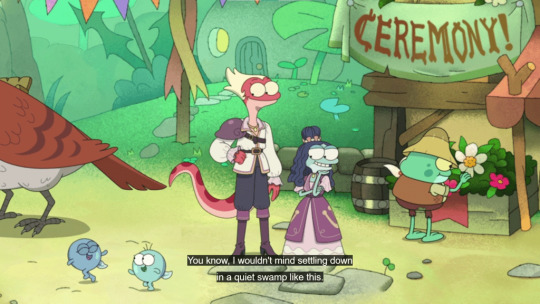
Lady Olivia (right) looks at General Yunan (left) lovingly and tells her she wouldn't mind "settling down" in Wartwood with Yunan.
Amphibia is rightly praised for illustrating issues like emotional manipulation, bullying, and delightful characters. The series could also be praised for broadening "ethnic-racial representations" like Craig of the Creek and Elena of Avalor. This is something that groups like the socially conservative family-oriented non-profit, Common Sense Media, would praise.
A 2021 report from the organization notes that when people of color are portrayed stereotypically, it causes harmful views to be promoted among White audiences. This is coupled with underrepresentation of specific groups, such as Latine and Indigenous people, and misrepresentation of others.
Little mentioned is LGBTQ representation in Amphibia. Although it isn't as direct as other recent series, like Dead End: Paranormal Park or The Owl House, Braly stated that in the show's finale, they left it open as to whether someone thinks of Sasha, Marcy, and Anne romantically or not, as he loves shipping. He called it the "greatest expression of love for characters."
This gives queer fans who ship Marcanne (Marcy and Anne), Sasharcy (Sasha and Marcy), Sashanne (Sasha and Anne), or even all three in a relationship together some solace. This the case even if this so-called "Calamity Trio" are only be "gal pals" in the show's canon.
Even so, Sasha was hinted as bisexual in the show's final episode, and confirmed as such by Braly, as I noted in an earlier post. Her voice actress, Akana, is bisexual herself. She voiced Daisy in magical girl esque Magical Friendship Girl Squad: Origins and Magical Girl Friendship Squad. In the case of Daisy, Akana argued that Daisy was bisexual. However, other crew members argued she was a lesbian, and possibly trans, leading to confusion among fans.
Coming back to Amphibia, Sasha joins other LGBTQ characters such as Frodrick Toadstool and Toadie who were confirmed as a gay couple by the show's creator. More significantly is Yunan (Zahra Fazal) and Lady Olivia (Michelle Dockery) as lesbian couple. There's also Ally and Jess who run an Internet video channel together. Their colors are based off the bisexual and pansexual flags.
It is also implied that Mr. X, voiced by RuPaul, is gay, and there are some other minor LGBTQ characters. Similar to Sasha, the sexual identities of these characters are never directly stated. Mr. X is an effeminate FBI agent assisted by a silent assistant named Jenny. After Anne and frog family escape to Amphibia, Anne's birth family convince Mr. X to hear them out and to be on the same side against Andrias. This results in the military and FBI assisting Anne and her friends in the final episode.
The relationship of Yunan and Olivia, was embraced by reviewers like Jade King, who calls herself "TheGamer’s Queen of Gay Cartoons." Braly told King that the ship of these two characters was their favorite ship. He called it "very organic" and "awesome." Fans were jubilant about the news, and fully embraced it. It undoubtedly helped that Fazal was inspired by the protagonist of Darkwing Duck in voicing the character.
Considering that the final episode has a ten year time-skip, it makes the series ripe for a possible spin-off or continuation that happens in that time skip, with different protagonists than this series. While some are conflicted about a spin-off, the show could go a route a la Steven Universe Future, focusing on the aftermath of a victory, with Anne, Marcy, and Sasha having to pick up the pieces.
All three seasons of Amphibia are currently streaming on Disney+, YouTube TV, and Prime Video.
© 2022-2023 Burkely Hermann. All rights reserved.
#amphibia#chosen family#self acceptance#anne boonchuy#matt braly#lgbtq#sasha waybright#marcy wu#kid cosmic#thai culture#thai creator#disney plus#bisexuals#lesbians#craig of the creek#elena of avalor
37 notes
·
View notes
Text
Class politics in the Knives Out franchise
A few weeks ago a friend of mine made a tiktok criticizing an article arguing that Glass Onion is bad anticapitalist media, on the basis that it's not anticapitalist media. Like, yeah, the villains of both films are rich people, but that's more of a plot device than a critique: death among rich folks entails a lot more motive, means, and opportunity for well-obscured murders to have taken place than among poor folks.
(For the record: I love these films and have watched both of them more than once, it's possible and even good to enjoy media with politics that are inconsistent with your own politics sometimes, and the argument I'm making here is definitely not the only legitimate interpretation of the text.)
Spoilers coming obv.
I commented on that video that the Knives Out films can even be read as critical not of wealth, per se, but of class mobility.
The format of both films are a man with an air of longstanding implicit wealth pursuing a career of excellence in his field more-or-less as a leisure activity, paired with a companion who has come into proximity to wealth, but does not desire that wealth, against a collection of horrible wealthy people, all of whom are desperately concerned with maintaining their wealth, and all of whose fortune is traceable to a specific, recent accomplishment of capitalist growth.
The protagonists of Knives Out do their best to perform the affect of old money, but that claim is discredited implicitly by the instability of the whole cast's financial support structure, and Benoit Blanc calls bullshit on it explicitly in the climax:
Ransom: You think I'm not gonna fight to protect my home, our birthright, our ancestral family home?
Blanc (laughing): That is hooey. Harlan, he bought this place in the 80s from a Pakistani real estate billionaire.
No such pretense exists among the shitheads in Glass Onion—for all its criticism of the bullshit of tech billionaires, the film absolutely lets Miles Bron have the character trait of being a self-made man who came from nothing that the heroes of tech bro masturbation fantasies all claim, few of them legitimately.¹
The murder victim in both films is the person whose exceptional abilities led to the wealth that all the suspects benefit from, and an interest in which highlights and focuses their character flaws. In this regard, the film deviates from the historical nobility narrative that the lower class is incapable of the kinds of accomplishments that are typical of the nobility—an attitude that has been visibly indefensible for hundreds of years—and instead takes up the more recent narrative that the lower classes just lack the wisdom and moral character to handle wealth. The victims, through their genius, create conditions for explosive wealth, and, through their sentimentality, share that power with the people close to them, who are naturally working-class people whose moral character is destroyed by exposure to fortune. Ultimately they discover that those with whom they have shared their success consider access to that success an inalienable right, and at least one of them in each film feels justified in defending that right by murdering them.
The murderers, thereafter, are each undone by the collaboration of a pair demonstrating rightful and just class dynamics: a noble gentleman, whose contributions consist principally of being present and being exceptional, rarely rising to the level of doing anything apart from telling other people what their roles and responsibilities are; and a member of the working class, so far in both films women of color, who works in a care industry (a nurse, a teacher) and has never aspired to wealth, and who takes action informed by a moral compass premised not on the position that she deserves the wealth at play, but that the suspects don't.
Blanc: I want you to remember something that's very important: you won not by playing the game Harlan's way, but yours. You're a good person.
Marta: This family. I should help them, right?
Blanc: Well, I have my opinion. But I have a feeling you'll follow your heart.
This all doesn't mean that Rian Johnson is, like, a feudalist, though. His oeuvre doesn't maintain any kind of coherent overarching attitude towards class. Anti class mobility isn't a core theme of The Brothers Bloom, which explicitly valorizes the accomplishment of stealing from rich people for personal gratification, and the opposite position—a rejection of hereditary or institutional criteria for legitimacy in power—is a core thesis of The Last Jedi. I only saw Looper once, a long time ago, but I don't remember any positive portrayal of wealth at all in it. And I'm sure I will watch Brick eventually. Johnson doesn't seem to think of storytelling as a means to an end; he doesn't seem to write with any motive other than doing a good job telling the story he's trying to tell. The politics of his films are whatever they need to be to create the genre that he's working in, and to do something he feels is worth doing with that genre.
Johnson absolutely could've worked in "Miles Bron came from money and lies about it" somehow, and it would've been more true to the storylines of tech billionaires in real life. But it would've added nothing to the story in its capacity as a murder mystery; the only thing to gain from adding that would be to adjust the shades of political implication that you can get from applying the text to reality. The only time I've seen Johnson transparently do things with a film because of their implications outside the text, it was in The Last Jedi, and the implications were on what Star Wars is and is capable of being as a cultural work. It was still about the story—even when the film is a means to an end, to Johnson, it's because the larger story is an end unto itself.
Notes:
The Musk Family emerald mine is an exaggeration but in his childhood Elon Musk belonged to a wealthy family. Bill Gates got the edge he had early in his career by having a huge amount of free access to computer processing time due to his family's academic connections and the private school he attended. Jeff Bezos was born into poverty, but his stepfather, whom his mother married when he was four, was an entrepreneur, and by the time Bezos was starting Amazon his parents could (and did) give him a quarter million dollar startup investment. Steve Jobs did grow up in a working class family; Apple co-founder Steve Wozniak came from somewhat more money, but still in the territory of 'very well-paid working class,' what we sometimes call the middle class in America. To the best of my knowledge, Apple's story is the only one in tech that even borders on resembling the bootstrap fantasy without a thick layer of outright lies spread on top.
19 notes
·
View notes
Text
How Magnificent Ms. Marvel deconstructs the "Chosen One" archetype
One element of the Destined arc from Saladin Ahmed's run on Magnificent Ms. Marvel that I find interesting is that it actively subverts orientalist and imperialist tropes present in sci-fi "chosen one saves alien planet" narratives.

Specifically, the whole idea of a human being whisked away to rescue an entire alien civilization from their own despotic dictator was heavily popularized by the comic-strip/serial show Flash Gordon, which was infamous for its usage of racist Yellow Peril tropes. Like not only was the main antagonist of Flash Gordon, Ming the Merciless, an overtly Yellow-Face Fu-Manchu caricature, but even the name of the planet he ruled, "Mongo," sounds awfully similar to the real-life Asian country of Mongolia. And this is made even more uncomfortable by the fact that Flash Gordon himself is the stereotypically glorified blonde-haired blue-eyed white male, and both the strip and serials portray him as liberating and conquering the planet Mongo from the obviously Asian-coded villain.

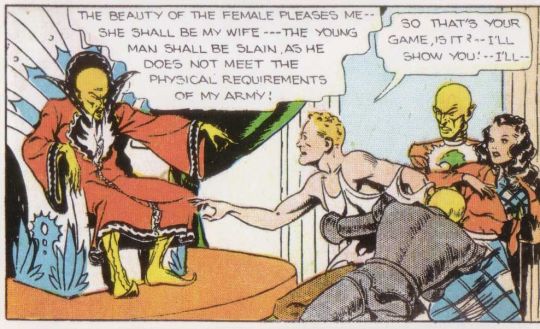
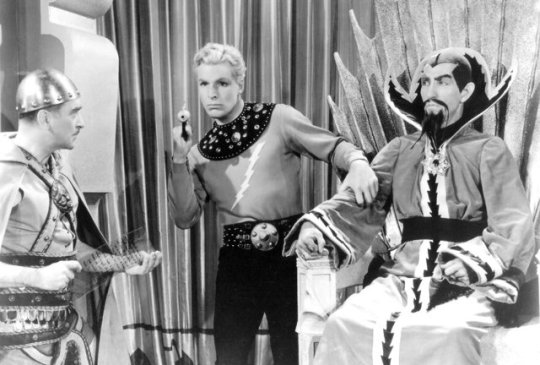
So yeah, there are definitely some imperialist and orientalist trappings within the "human saves alien planet" narrative. However, while the Destined arc of Magnificent Ms. Marvel is clearly modeled after this archetypal narrative, there are plenty of ways in which it both subverts and deconstructs this type of plot IMO. Immediately right off the bat one of the key methods in which Destined avoids the same White Savior trapping as Flash Gordon does is through the fact that although the protagonist Kamala Khan is an American, she's simultaneously a brown Muslim Girl who comes from a first-generation Pakistani immigrant family. So that alone already subverts the traditional "chosen one/savior" archetype by having the main character be a woman of color instead of a white man.
Plus the author of Magnificent Ms. Marvel, Saladin Ahmed, is a Lebanese-American Muslim, whereas Flash Gordon's creator, the late Alex Raymond, was a white man.

Furthermore, what also helps the Ms. Marvel arc is that even though the alien civilization of Saffa which Kamala and her parents visit is clearly modeled after Arabic and Middle Eastern cultures, it avoids the orientalist trappings since this coding reads much closer to Kamala's own Muslim identity and the story even draws direct parallels between the two. While of course Pakastini and Arabic cultures are not the same and bear distinctions between each other, there is still some overlap between them especially through shared Islamic traditions, which is a huge deviation and contrast from the clearly all-American Flash Gordon versus the obviously Yellow-Peril inspired Ming the Merciless.


Lastly, in an interesting twist it's actually not the theocratic dictator which Kamala saves the planet Saffa from, but rather from the invading hordes of a rival alien empire who were mentioned in the the "Destined One" legend that the Saffans' believed Kamala was a part of. And the Saffan dictator, Maliq Zeer, who was previously built up in the narrative as the traditional final boss ends up putting aside his own evil agendas in order to prevent his planet's annihilation.
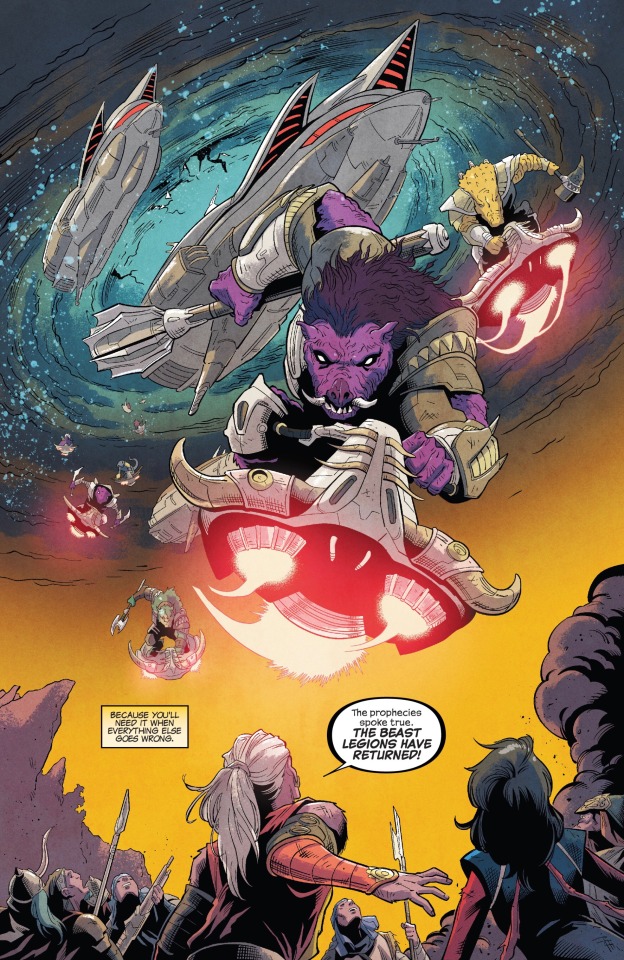

Plus, the entire story is focused on deconstructing the chosen one trope by examining how various other characters view Kamala as a hero, as well as her own struggles with this sort of glorification whilst still trying to protect others simply because its the right thing to do.

And while I've seen some people argue that the Saffan's "magic = Islam" which therefore "intrinsically roots violence in their beliefs and has such messed up connotations," it's outright stated or heavily implied in the Destined arc that that Maliq Zeer and his priest's version of the "Destined One" legend was a perversion of the planet's normal belief system to amass their own political power, which said dictator is willing to put aside when the Beast Legions from the legend return in the arc's climax. Heck, even the aforementioned "call for prayer" that Cheb Hura (Maliq Zeer's son and the leader of a band of rebel freedom fighters) mentioned previously was coded as something positive rather than negative since it was banned by the theocratic dictator.
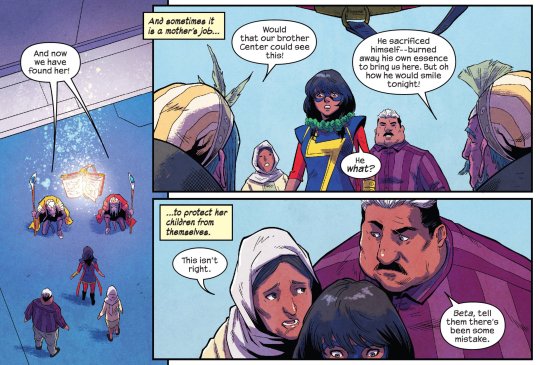

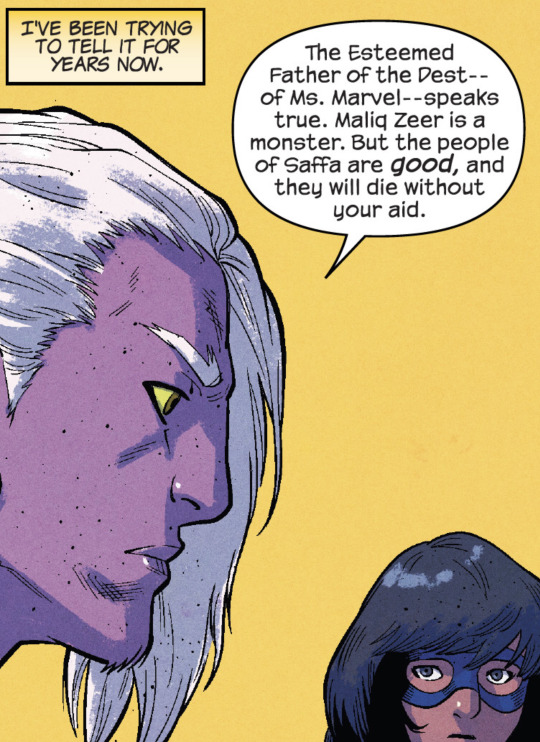

So overall, I personally felt that while Saladin Ahmed’s Destined arc was playing with the “human saves alien civilization” narrative that was typical in old sci-fi serials like Flash Gordon, he simultaneously avoids a lot of the problematic white-savior and imperialist/orientalist tropes which also predominated those older stories due to Kamala’s own status as a Pakistani-American Muslim girl, the subverting of the tropes found in these kinds of narratives, as well as the overall framing around the Arab-coded alien civilization.
#kamala khan#ms marvel#magnificent ms marvel#saladin ahmed#marvel#comics#minkyu jung#flash gordon#mini essay
10 notes
·
View notes